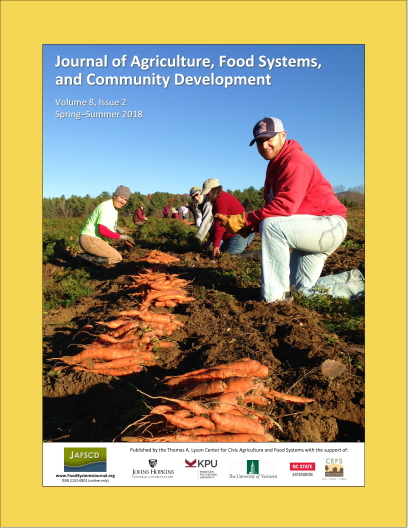Salvageable Food Losses from Vermont Farms
DOI:
https://doi.org/10.5304/jafscd.2018.082.006
Keywords:
Berry Production, Food Loss, Food Waste, Imperfect Produce, Quantification, Small Farms, Survey, Vegetable ProductionAbstract
For a variety of reasons, farms cannot sell or donate all the food they produce, and some food crops are lost from the food supply. Food lost at the farm level represents a substantial environmental, economic, and nutritional cost to the food system. Few studies have estimated amounts of food lost at the farm level in the U.S. We present a survey-based method for estimating crop loss quantities based on four estimates by farmers: percent available crops that are harvested, percent unharvested crops they would consider edible, percent harvested produce sold, and percent harvested produce donated. We applied the method in an online survey administered to 58 Vermont vegetable and berry farms. Within the sample, an estimated 16% of vegetables and 15% of berries were considered lost but salvageable in 2015. If these farms are representative of farms across the state, this would amount to approximately 13,684,000 lbs. (6,207,000 kg) of salvageable vegetables and 589,000 lbs. (267,000 kg) of salvageable berries. This lost produce contains substantial nutrients. For example, the amount of lost fiber is equivalent to the gap between actual and recommended fiber intake for 36,000 adult U.S. women. Most estimates are based on recall. While many farmers reported keeping records of crops harvested (67%) and sold (69%), few had records of other quantities needed for tracking losses. Sixty percent of farmers expressed interest in a state program that would compensate farmers for donations and nearly half expressed interest in one or more strategies to involve community groups in reducing losses. While not all produce that is lost can realistically be provided to consumers in a timely and cost-effective manner, this research highlights a high magnitude of loss and potentially, a considerable nutritional and economic opportunity. Further research is needed to confirm and add depth to these estimates and to evaluate potential solutions.
See the press release for this article.
Metrics
Downloads
Published
How to Cite
Issue
Section
License
Copyright (c) 2018 Roni A. Neff, Elana K. Dean, Marie L. Spiker, Theresa Snow

This work is licensed under a Creative Commons Attribution 4.0 International License.
The copyright to all content published in JAFSCD belongs to the author(s). It is licensed as CC BY 4.0. This license determines how you may reprint, copy, distribute, or otherwise share JAFSCD content.














